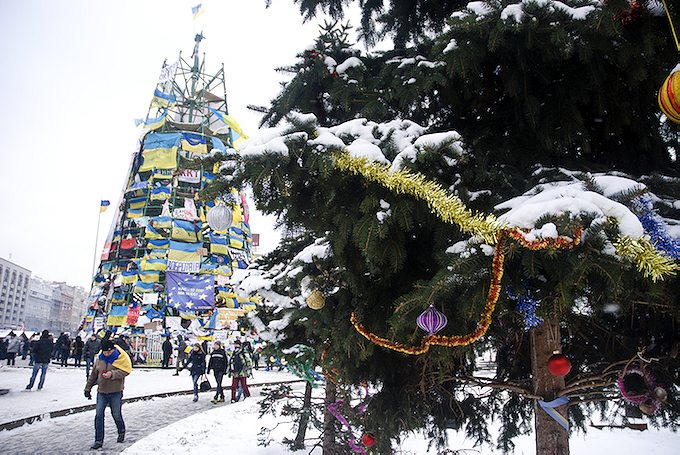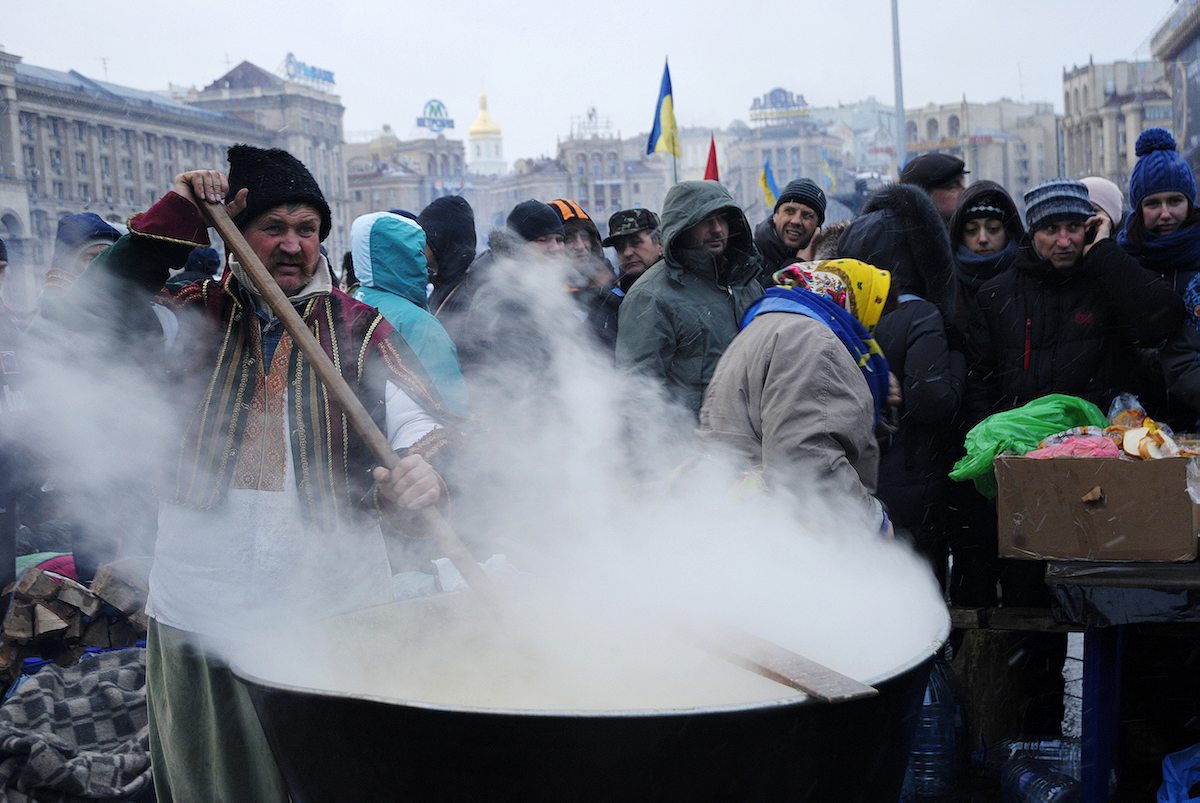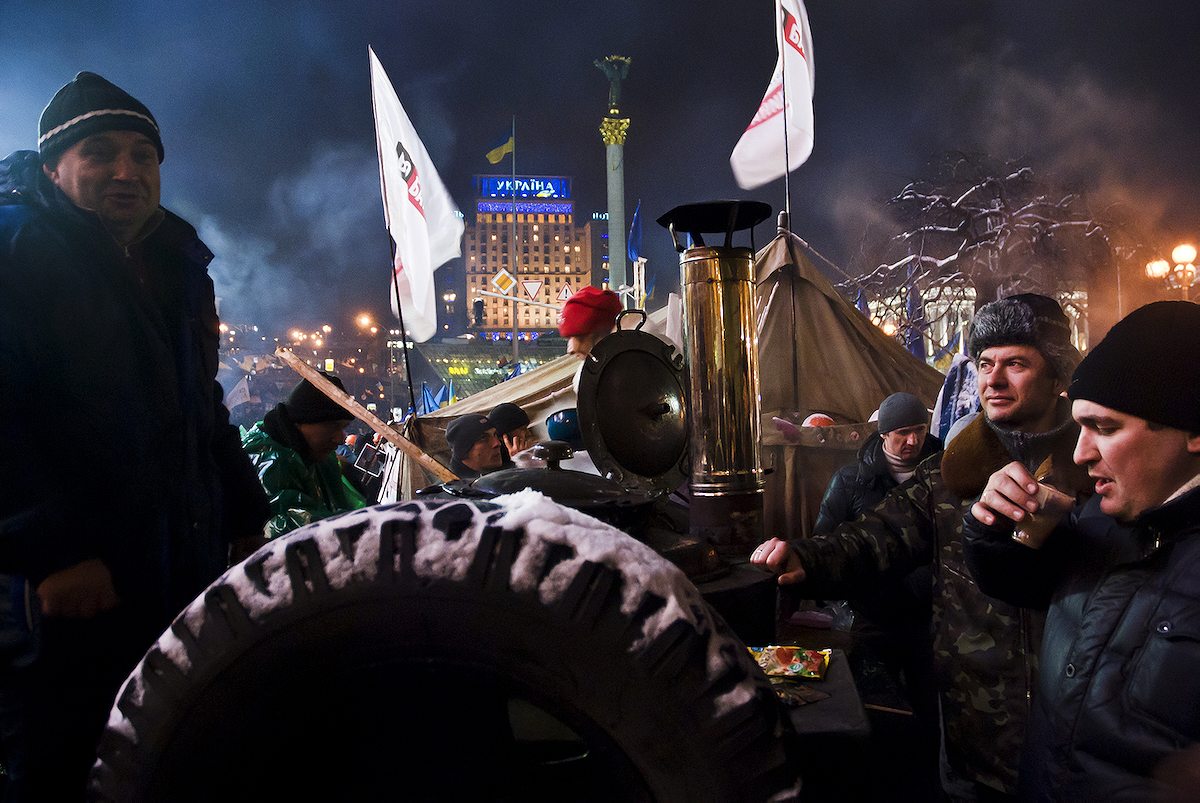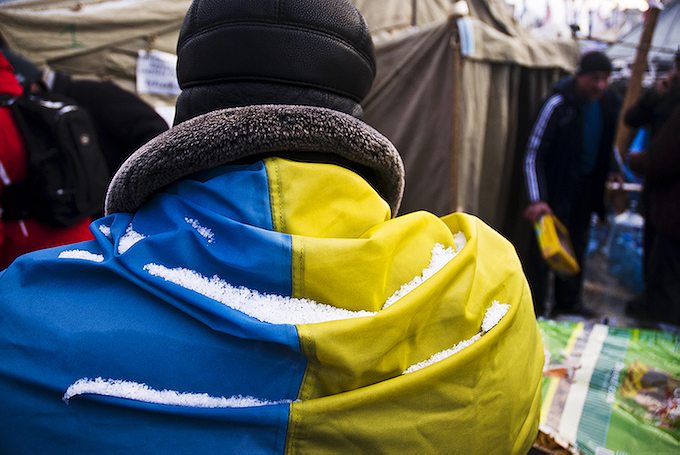One major difference between the Euromaidan street uprising in Kiev and the ones that kickstarted Arab Spring: it’s freezing out here.
KIEV, Ukraine—
The week began with this tweet from the possibly authentic Twitter account of Ukraine’s President Viktor Yanukovich: “Over next few days it will cool significantly. Dress warmer or spend time at home with family. #PresidentsTip.”
Yanukovich, who is currently facing the wrath of Kiev’s massive Euromaidan protests, isn’t known for his compassion. (In his two presidential campaigns, his first opponent was poisoned and the second is now in jail). But he might have a point—for once. This is no Arab Spring: It is ridiculously cold out here.
Ukraine’s demonstrations began last month after Yanukovich walked away from a deal with the European Union in favor of closer ties to Russia. As winter has set in, the protests have snowballed into a sustained anti-government rally. But on Kiev’s Independence Square—known as the Maidan—protesters face not only riot police, but also snow and ice.

On my first evening at the Maidan, fat snowflakes fell on the tent city clustered on one side of the square, a labyrinth of tents, railings, and metal barrels with logs set aflame inside. Two men beckoned me to join them by their barrel, blue eyes set against faces reddened by the cold. The snow melted when it touched the back of my hands, and soon my palms were broiling. Next to me a middle-aged woman warmed her scarf, which had frozen around her neck.
Kiev in winter would seem completely inhospitable to street protests. But a weatherman on Russia 24 drew the opposite conclusion, finding a link between icy weather and unrest in the Ukrainian capital. After all, the 2004 Orange Revolution took place exactly nine years ago, in the same bitter temperatures. “Maybe it’s no coincidence,” he speculated.

In spite of the elements, the pro-Europe protesters have built a thriving winter village. Clouds of steam rise from field kitchens, where volunteers serve food around the clock. On Sunday, I got a bowl of clear soup, sprinkled generously with fresh chives and dill. Burly men munched on bread with salo, slabs of pork fat, washing it down with strong, sweet tea ladled into disposable cups. Best of all was the tea served with kalyna, a bright red berry, or coffee boiled in a vat with sweetened condensed milk. Surprisingly, there was no alcohol to be seen—this will not be a vodka-warmed revolution. People needed to be alert, and the volunteer guards don’t let drunks pass through the barricades.

There is some indoor space, however. The newly minted Revolution HQ is the occupied city hall, a stone’s throw from the Maidan. By the entrance to the building, a hand-drawn poster explains that the protesters’ headquarters needed medicine, food, money, warm clothes, and gas masks. The heavy rotating doors lead into a hive of activity. Downstairs there were tables spread with more food, and even a makeshift shrine with candles. In the toasty grand hall upstairs, protesters dozed on colorful blankets that stretch across the room like a vast oriental rug. One corner harbored a medical center, with a sign that said “PSYCHOLOGIST.”

Revolutionary streetwear tends toward the practical: padded coats are most common, sometimes one-piece ski suits. Occasionally, women show up in luxurious fur coats and matching hats, as if they just came straight off the set of Anna Karenina. Draping a Ukrainian flag over the shoulders adds extra warmth. For those who come unprepared, mounds of donated jumpers and coats are available. The Lithuanian ambassador was spotted handing out wool mittens to protesters in a gesture of European solidarity. And as fear of a police raid mounts, more and more people are wearing helmets, which protect the skull but aren’t always as good at keeping ears warm.
Faced with massive protests, Ukraine’s Ministry of the Interior attempted to calculate how many people could fit on the Maidan, taking into account their bulky winter clothes. The number they come up with—a mere 100,000—was far lower than actually turned out.

Music pounds out day and night, courtesy of a stream of live acts on the stage. Cries of “Slava Ukraini!” (Glory to Ukraine) erupted almost spontaneously along the barricades. Late into the night, people danced, played soccer, or joined in singing the Ukrainian national anthem led by Ruslana, Ukraine’s Eurovision pride. Someone arrived with more tea. “It’s cold out here but our hearts are warm,” a presenter coos.
On Monday, Kiev woke up to snow. After the previous day’s massive turnout, everyone feared that a crackdown was near. Revolution HQ was looking the worse for wear. The smell was dank, the parquet upstairs blackened by wet shoes, and most of the blankets were gone. The psychologist was nowhere to be seen. Behind me, a young man wearing an army helmet started whacking himself on the forehead with a plank, testing his battle-gear.

Protesters have tried to melt the hearts of the policemen who are stationed around the Maidan, their young faces rosy with cold. Someone reached up to brush the snow off a policeman’s shoulders. Others brought hot tea and offered to share sweets or sandwiches with them. Sometimes the policemen said they weren’t permitted to take the protesters’ offerings, sometimes they accepted.
The Maidan is no longer simply a public square; it’s a winter fortress.
The storm passed, and the next day camp was putting itself back together. The temperature inched toward 14 degrees and the sun poked out. Volunteers shoveled snow and sprinkled the ground with salt, drying their blankets over fires. Wooden shelters popped up along the Maidan’s perimeter, just inside the barricades. On the other side, a car drew up and men began unloading logs, ready to fuel the field kitchens and campfires. One volunteer staggered past carrying what looked like the trunk of half a silver birch. Tucked between tents, a group had made a heater by joining two metal barrels and laying them on the ground, with a pipe as a chimney. “This is our steam engine—our steam engine to Europe,” they laughed.

As the week wore on, protesters learned how to make the cold their ally. When the riot police arrived on Tuesday night, protesters poured water outside Revolution HQ to create an ice-rink for the officers to slip on. Demonstrators chipped the ice and used it to reinforce the barricades. They built walls by stacking sacks of snow. The Maidan is no longer simply a public square; it’s a winter fortress.
And many are planning for a long winter. “I personally will be here on New Year’s Eve,” says a civil society activist as she offers me a wet wipe to clean the salt, snow, and grime off my boots. “Each of us will decide for himself.”
<em>Top image: A woman sings the national anthem during a rally at Kyiv’s Independence Square. Photo by: Anastasia Vlasova.</em>
